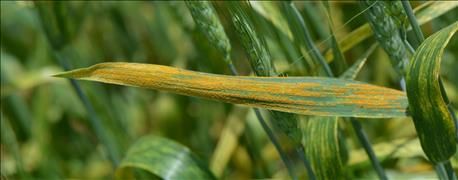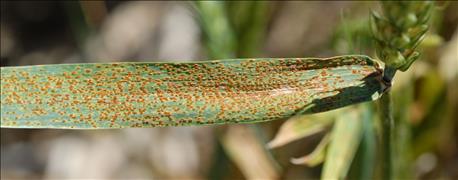
Despite some freezing temperatures in recent weeks, and Nebraska's winter wheat crop being a little further along than usual, crop conditions are looking good.

WATCH FOR STRIPE RUST: As of early April, stripe rust has been identified as far north as I-70 in Kansas and northeast of Denver in Colorado. Stripe rust, identifiable by yellow streaks or stripes that run parallel to the leaf, is favored by wet conditions and cooler temperatures – optimal conditions for stripe rust are around 50 to 59 degrees Fahrenheit. Photo credit: Stephen Wegulo.
"I thought maybe the recent storm with low temps might result in some winter injury, but it actually didn't, because most of the wheat hadn't jointed yet," says Stephen Wegulo, University of Nebraska Extension plant pathologist. "When the wheat is already jointed and the first node is detectable or a lot of foliage has grown and we have sub-freezing temperatures that's when we can have significant injury. We didn't have much winter injury. There was just some leaf tip burn from the cold temperatures, but usually the wheat comes out of that pretty quickly. If we have a freeze in mid-to-late April, however, that will be a problem."
But there are more challenges to the 2016 winter wheat crop on the horizon – most notably, stripe rust and leaf rust. In late March, leaf rust was confirmed in Nuckolls County. But more severe is the threat of stripe rust. As of early April, stripe rust had been detected as far north as I-70 in Kansas, and northeast of Denver in Colorado. "So that poses some risk to western Nebraska because it can easily blow into the Panhandle. However, the biggest risk is spores blowing in from Kansas, which is directly south of us," says Wegulo. "It's a matter of time, I believe in the next week or two we will have stripe rust especially in the southern counties."

LEAF RUST CONFIRMED: In late March, leaf rust was confirmed in Nuckolls County. Leaf rust is favored by warmer conditions around 60 to 72 degrees and is identifiable by small brown randomly scattered pustules on the leaf blade. Photo credit: Stephen Wegulo.
Stripe rust, identifiable by yellow streaks or stripes that run parallel to the leaf, is favored by wet conditions and cooler temperatures – optimal conditions for stripe rust are around 50 to 59 degrees Fahrenheit. Leaf rust is favored by warmer conditions around 60 to 72 degrees and is identifiable by small brown randomly scattered pustules on the leaf blade.
However, it's a little early yet to spray fungicide to control these diseases. "If growers see stripe rust, leaf rust or both, then we encourage the best time for an early application is around Feekes 5 to Feekes 6," explains Wegulo. "Feekes 5 is when the leaf sheaths are fully erected, the stage just before the first node is detectable. Feekes 6 is when the first node is detectable."
If growers aren't able to spray, it's best to apply at Feekes 9 – when the flag leaf has emerged. "At flag leaf, timing is critical because not only will it control stripe rust but a whole host of other leaf diseases – leaf spot septoria, tan spot, powdery mildew, all those diseases are targeted," Wegulo says. "We really encourage growers to plan for a flag leaf application and monitor their fields. Right now the current weather we have and what is forecasted is perfect for stripe rust. We'll see in the next couple of weeks, once the wheat starts growing we'll have a better picture."
For additional information, contact Wegulo at [email protected].
About the Author(s)
You May Also Like






